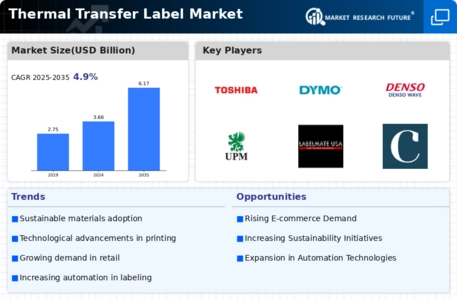Increased Regulatory Compliance
The Thermal Transfer Label Market is also being driven by the need for increased regulatory compliance across various sectors. Industries such as pharmaceuticals, food and beverage, and chemicals are subject to stringent labeling requirements to ensure safety and traceability. As regulations become more complex, companies are turning to thermal transfer labels that can provide essential information in a clear and durable format. This trend is likely to propel the market forward, as businesses invest in labeling solutions that meet compliance standards while also enhancing consumer trust and product safety.
Rising Demand for Customization
The Thermal Transfer Label Market is experiencing a notable increase in demand for customized labeling solutions. Businesses across various sectors, including retail and logistics, are seeking labels that can be tailored to their specific branding and operational needs. This trend is driven by the need for enhanced product differentiation and consumer engagement. According to recent data, the customization segment is projected to grow at a compound annual growth rate of approximately 5.2% over the next five years. As companies strive to create unique identities, the Thermal Transfer Label Market is likely to benefit from this shift towards personalized labeling solutions.
Technological Innovations in Labeling
Technological advancements are playing a crucial role in shaping the Thermal Transfer Label Market. Innovations such as improved printing technologies and materials are enhancing the quality and efficiency of label production. For instance, the introduction of high-resolution thermal transfer printers has enabled businesses to produce labels with superior graphics and barcodes, which are essential for inventory tracking and product identification. The market is expected to witness a growth rate of around 4.8% annually, driven by these technological improvements that enhance operational efficiency and reduce costs in the labeling process.
Expansion of E-commerce and Online Retail
The ongoing expansion of e-commerce and online retail is significantly influencing the Thermal Transfer Label Market. With the rise of online shopping, there is an increasing need for efficient labeling solutions that facilitate shipping and inventory management. The market for thermal transfer labels is expected to grow as businesses require labels that can withstand various shipping conditions while maintaining clarity and durability. Recent statistics indicate that e-commerce sales are projected to reach over 6 trillion dollars by 2024, which could lead to a corresponding increase in demand for thermal transfer labels, thereby bolstering the market.
Sustainability and Eco-friendly Practices
Sustainability initiatives are increasingly influencing the Thermal Transfer Label Market. As consumers become more environmentally conscious, companies are seeking labeling solutions that align with eco-friendly practices. This includes the use of recyclable materials and inks in thermal transfer labels. The market is witnessing a shift towards sustainable labeling options, which is expected to grow at a rate of approximately 6% over the next few years. By adopting sustainable practices, businesses not only meet consumer expectations but also contribute to environmental conservation, thereby enhancing their brand image in the Thermal Transfer Label Market.


















Leave a Comment